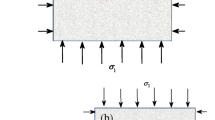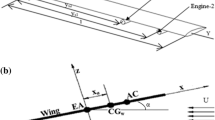Abstract
By considering the effect of hydraulic pressure filled in wing crack and the connected part of main crack on the stress intensity factor at wing crack tip, a new wing crack model exerted by hydraulic pressure and far field stresses was proposed. By introducing the equivalent crack length l eq of wing crack, two terms make up the stress intensity factor K I at wing crack tip: one is the component K (1)I for a single isolated straight wing crack of length 2l subjected to hydraulic pressure in wing crack and far field stresses, and the other is the component K (2)I due to the effective shear stress induced by the presence of the equivalent main crack. The FEM model of wing crack propagation subjected to hydraulic pressure and far field stresses was also established according to different side pressure coefficients and hydraulic pressures in crack. The result shows that a good agreement is found between theoretical model of wing crack proposed and finite element method (FEM). In theory, an unstable crack propagation is shown if there is high hydraulic pressure and lateral tension. The wing crack model proposed can provide references for studying on hydraulic fracturing in rock masses.
Similar content being viewed by others
References
CAI M. Influence of intermediate principal stress on rock fracturing and strength near excavation boundaries-Insight from numerical modeling [J]. International Journal of Rock Mechanics & Mining Sciences, 2008, 45: 763–772.
SAHOURYEH E, DYSKIN A V, GERMANOVICH L N. Crack growth under biaxial compression [J]. Eng Fract Mech, 2002, 69(18): 2187–2198.
CAI M, KAISER P K. Assessment of excavation damaged zone using micromechanics model [J]. Tunnelling and Underground Space Technology, 2005, 20(4): 301–310.
ASHBY M F, SAMMIS. The damage mechanics of brittle solids in compression [J]. Pageoph, 1990, 133(3): 489–518.
HORII H, NEMAT-NASSER S. Compression-induced microcrack growth in brittle solids: Axial splitting and shear failure [J]. J Geophys Res, 1985, 90: 3105–3125.
HORII H, NEMAT-NASSER S. Brittle failure in compression: Splitting, faulting and brittle-ductile transition [J]. Phil Trans R. Soc Lond A, 1986, 139: 337–374.
ASHBY M F, HALLAM S D. The failure of brittle solids containing small cracks under compressive stress states [J]. Acta Metall, 1986, 34: 497–510.
STEIF P S. Crack extension under compressive loading [J]. Engng Fract Mech, 1984, 20: 463–473.
BAUD P, REUSCHLE T, CHARLEZ P. An improved wing crack model for the deformation and failure of rock in compression [J]. International Journal of Rock Mechanics and Mining Sciences and Geomechanics Abstracts, 1996, 33(5): 539–542.
WANG Yuan-han, XU Yue, TAN Guo-hua. An improved calculative model for wing crack [J]. Chinese Journal of Geotechnical Engineering, 2000, 22(5): 612–615. (in Chinese)
NAKASHIMA Y. Buoyancy-driven propagation of an isolated fluid-filled crack in rock: Implication for fluid transport in metamorphism [J]. Contributions to Mineralogy and Petrology, 1993, 11(4): 289–295.
TANG Lian-sheng, ZHANG Peng-cheng, WANG Si-jing. Testing study on effects of chemical action of aqueous solution on crack propagation in rock [J]. Chinese Journal of Rock Mechanics and Engineering, 2002, 21(6): 822–827. (in Chinese)
ZHUANG Ning. Propagation rule of crack rock mass and its mathematics model research under the hydraulic-stress coupling [D]. Shanghai: TongJi University, 2006: 111–112. (in Chinese)
KATSUMI, N, HIROKAZU M, HIROAKI, N, NORIYOSHI T. Mechanical and hydraulic coupling of injection-induced slip along pre-existing fractures [J]. Geothermics, 2008, 37: 157–172.
LEE M Y, HAIMSON B C. Statistical evaluation of hydraulic fracturing stress measurement parameters [J]. Int J Rock Mech Min, Sci & Geomech Abstr, 1989, 26: 447–56.
LUO Xiao-rong, VASSEUR G. Natural hydraulic cracking: numerical model and sensitivity study [J]. Earth and Planetary Science Letters, 2002, 20(1): 431–446.
PAPANASTASIOU P C. A coupled elastoplastic hydraulic fracturing model [J]. Int J Rock Mech & Min Sci, 1997, 34: 3–4.
ZHAO Y L, CAO P, WANG W J. Viscoelasto-plastic rheological experiment under circular increment step load and unload and nonlinear creep model of soft rocks [J]. Journal of Central South University of Technology, 2009, 16(3): 484–491.
LAUTERBACH B, GROSS D. Crack growth in brittle solids under compression [J]. Mechanics of Materials, 1998, 29: 81–92.
LEE S, RABICHANDRAN G. Crack initiation in brittle solids under multiaxial compression [J]. Engineering Fracture Mechanics, 2003, 70: 1645–1658.
DYSKIM A V, SAHOURYEH E, JEWELL R J, JOER J H, USTINOV K B. Influence of shape and locations of initial 3-D cracks on their growth in uniaxial compression [J]. Engineering Fracture Mechanics, 2003, 70: 2115–2136.
SAHOURYEH E, DYSKIM A V, GERMANOVICH L N. Crack growth under biaxial compression [J]. Engineering Fracture Mechanics, 2002, 69: 2187–2198.
YU Xiao-zhong. Fracture mechanics of rock and concrete [M]. Changsha: Central South University of Technology Press, 1991: 20–21. (in Chinese)
AYATOLLAHI M R, ALIHA M R M. Wide range data for crack tip parameters in two disc-type specimens under mixed model loading [J]. Computational Materials Science, 2007, 38(4): 660–670.
ZHAO Yan-lin, CAO Ping, WEN You-dao. Damage fracture failure mechanism of compressive-shear rock cracks under seepage pressure [J]. Journal of Central South University: Science and Technology, 2008, 39(4): 838–844. (in Chinese)
Author information
Authors and Affiliations
Corresponding author
Additional information
Foundation item: Projects(10972238, 51074071, 50974059) supported by the National Natural Science Foundation of China; Project(10JJ3007) supported by the Natural Science Foundation of Hunan Province, China; Project(11C0539) supported by Scientific Research Fund of Hunan Provincial Education Department, China; Project(200905) supported by Open Research Fund of Hunan Provincial Key of Safe Mining Techniques of Coal Mines, China
Rights and permissions
About this article
Cite this article
Zhao, Yl., Cao, P., Wang, Wj. et al. Wing crack model subjected to high hydraulic pressure and far field stresses and its numerical simulation. J. Cent. South Univ. Technol. 19, 578–585 (2012). https://doi.org/10.1007/s11771-012-1042-1
Received:
Accepted:
Published:
Issue Date:
DOI: https://doi.org/10.1007/s11771-012-1042-1




